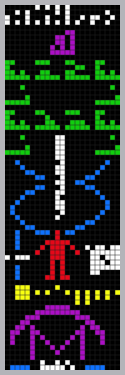Arecibo message

The Arecibo message was a short radio message sent into space to celebrate the remodeling of the Arecibo radio telescope in Puerto Rico in 1974.[1] It was aimed at the globular star cluster M13, about 25,000 light years from Earth. M13 was chosen because it was the right size, and was in the sky at the right time and place for the ceremony.[2]
Dr. Frank Drake, then at Cornell University and creator of the famous Drake equation, wrote the message, with help from Carl Sagan, among others.[1] The message was in seven parts which show:[3]
- The numbers one (1) to ten (10)
- The atomic numbers of the elements hydrogen, carbon, nitrogen, oxygen, and phosphorus, which make up deoxyribonucleic acid (DNA)
- The formulas for the sugars and bases in the nucleotides of DNA
- The number of nucleotides in DNA, and a graphic of the double helix structure of DNA
- A figure of a human, the size of an average man, and the human population of Earth
- The Solar System
- The Arecibo Observatory and the diameter of the transmitting antenna dish
It will take 25,000 years for the message to reach the stars, and at least another 25,000 years to get any reply. This means the Arecibo message was a show of human technological achievement, not a real attempt to talk to extraterrestrial life. The stars of M13 that the message was aimed at will no longer be in that location when the message arrives.[1] Cornell University said on November 12, 1999, the real purpose of the message was not to make contact, but to show the power of the new equipment.[1] (Cornell University had built and operated the radio telescope for the United States National Science Foundation.)
The message consisted of 1679 binary digits, about 210 bytes. It was transmitted at a frequency of 2380 MHz and modulated by shifting the frequency by 10 Hz, with a power of 1000 kW. The "ones" and "zeros" were transmitted by frequency shifting at the rate of 10 bits per second. The total broadcast was less than three minutes.[1][4]
The cardinality of 1679 was chosen because it is a semiprime. It can be arranged as a rectangle of 73 rows by 23 columns. The other arrangement, 23 rows by 73 columns, does not produce a meaningful result. The message forms the image shown on the right, or its inverse, when translated into graphics characters and spaces.[3]
In 2009 the band Boxcutter made an album called the Arecibo Message, which has a lot of short songs.[5]
References[change | change source]
- ↑ 1.0 1.1 1.2 1.3 1.4 "Cornell News: It's the 25th anniversary of Earth's first (and only) attempt to phone E.T., FOR RELEASE: Nov. 12, 1999". Archived from the original on 2008-04-17. Retrieved 2008-03-29./
- ↑ "Larry Klaes. Ithaca Times - Making Contact (11/30/2005)". Archived from the original on 30 September 2007. Retrieved 2007-07-27.
- ↑ 3.0 3.1 Cassiday, George. "The Arecibo Message". Archived from the original on 2007-07-17. Retrieved 2007-07-27.
- ↑ Jay M. Pasachoff. "Chapter 20: Life in the Universe". Astronomy: From the Earth to the Universe, Updates by Chapter, 5th Ed. Retrieved 2007-05-05.
- ↑ "Planet Mu Records". planet.mu. 2011. Archived from the original on 2011-08-11. Retrieved 2011-07-05.
